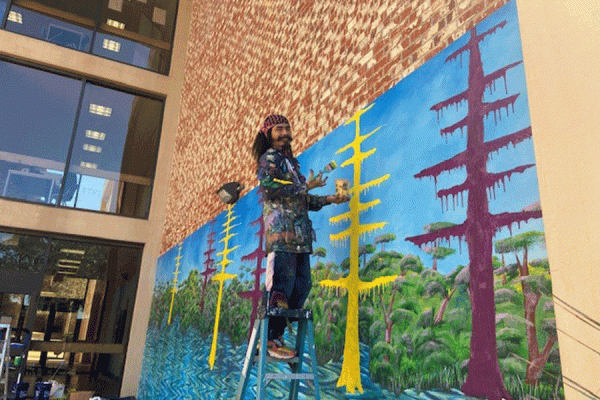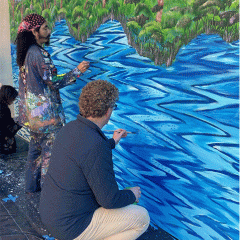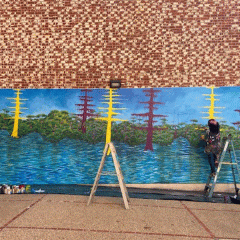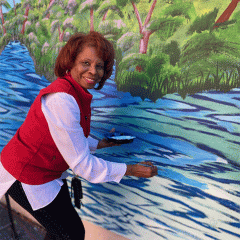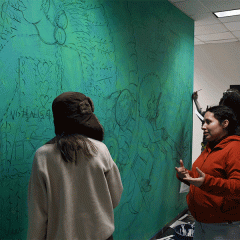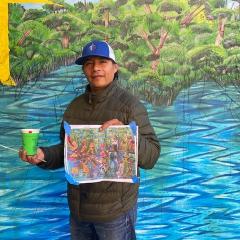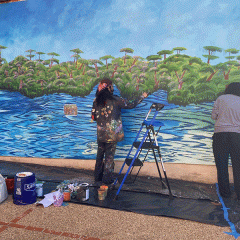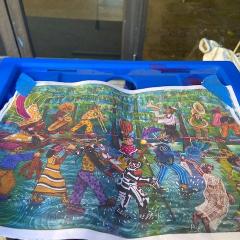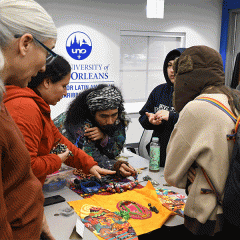The vivid splashes of yellows, greens and blues immediately capture the attention of passers-by who are bearing witness to the colorful mural emerging from the bricks of the Education Building on the University of New Orleans campus. On Friday, upon closer inspection, one could see the outline of a second line parade seemingly dancing above the turquoise water of a bayou while the trees stand as sentinels.
The outdoor artistry is at the hands of three muralists who have formed the artist collective Raiz de la Ceiba and anyone else who quiero pintar – wants to paint. The muralists are from Guerrero, Mexico and follow a participatory method that welcomes the UNO community to come paint with them, said Roberto Barrios, anthropology professor and director of the University of New Orleans Center for Latin American and Caribbean Studies.
The visit was made possible with help from Scott Pentzer, director of UNO’s interdisciplinary studies program, an anonymous UNO Foundation donor, the Doris Zemurray Stone Latin American Endowment, and the US-Mexico Commission for Educational and Cultural Exchanges (COMEXUS), Barrios said.
Over the course of five weeks the trio—muralists Baltazar Castellano Melo, Olga Manzano and Jose Luis Hernandez who collectively call themselves Raiz de la Ceiba or Root of the Ceiba Tree—will create two murals on campus. One is on the outside south wall entrance to the Education Building and the other is on a wall inside a lounge in the International Center.
The murals are expected to be completed by Feb. 20, Barrios said.
“I want the UNO community to learn that Mexico is home to a number of Afro-descended communities, many of them located in the state of Guerrero,” Barrios said. “Our guest muralists have dedicated their careers to raising awareness of the history and contributions of Afro-Mexican and Indigenous people to both Mexico and the United States.”
Guerrero is a state of origin for many migrant laborers who come to the United States to work in construction, agriculture and other industries, and their labor is indispensable to the American economy, Barrios said.
“I also want the UNO community to know that Mexico, and Latin America in general, have a long history of connection with and presence in New Orleans and that our histories are inseparably intertwined,” he said.
The mural in the International Center honors the contributions made by migrant workers during the rebuilding of New Orleans following Hurricane Katrina in 2005.
“More than 30 percent of the reconstruction labor force were people born in Latin American countries and they labored under hazardous conditions to bring our wonderful city back from disaster,” Barrios said. “This mural also honors the connections and solidarities between Afro-descended people in Mexico and the United States.”
For example, many enslaved people fled the U.S. for Mexico, which abolished slavery before the United States, and passed laws to protect them from bounty hunters. During the Jim Crow era, many people in New Orleans also moved to Mexico to escape segregation, Barrios said.
“The mural features Mardi Gras Indian Fi Yi Yi, who is retiring this year, holding a spear with a ‘Diablo,’ one of the Afro-Mexican masking traditions of Guerrero. Their grasp on the same spear is meant to symbolize solidarity,” Barrios said.
The mural outside of the Education Building will feature figures from the masking and musical traditions of Guerrero, Mexico and New Orleans, including Big Chief Sunpie of the Skull and Bones Mardi Gras group. It will also include devils, jaguars, second line musicians and Mardi Gras Indians.
“They walk on the water of a bayou, which symbolizes a spiritual journey,” Barrios said. “Movement, migration, solidarity and connections between Mexico and New Orleans are big themes in this mural as well.
“The dancers move to the backdrop of a bayou where animals act as observers and judges of ethical behavior.”
The artists are working on the murals simultaneously, weather permitting, typically from 9 a.m. to 9 p.m. Monday through Friday and from 10 a.m. to 6 p.m. Saturday and Sunday.
“Stop by, say ‘Hola, quiero pintar.’ (Hi, I want to paint) and they will be glad to include you in their work,” Barrios said.


